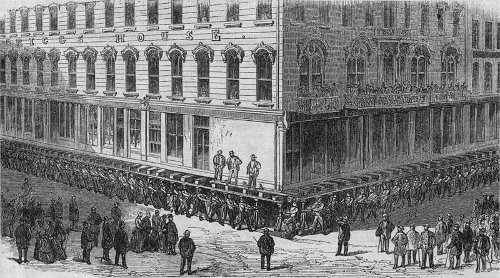
Chicago faced a public health crisis in the 1850s as poor drainage led to outbreaks of cholera and typhoid fever. So they raised the town. Large sections of the central city were raised 6 feet on jackscrews while masons installed new foundations beneath them and installed pipes for sewage, water, and gas.
Surprisingly, this went pretty well. “An entire block on Lake street, between Clark and La Salle streets, on the north side of the street, was raised at one time, business in the various stores and offices proceeding as usual,” wrote historian Josiah Seymour Currey. “The facility with which buildings, light and heavy, were raised to the grade established became the talk of the country, and the letters of travelers and correspondents for newspapers abound with reference to the work going on and the odd sensations of going up and down as one passed along the streets.”
One oddity: The streets were raised before the sidewalks, so “until all the sidewalks were raised to grade, people had to go up and down stairs from four to half a dozen steps two or three times in passing a single block,” recalled Chicago Tribune publisher William Bross. “A Buffalo paper got off a note on us to the effect that one of her citizens going along the street was seen to run up and down every pair of cellar stairs he could find. A friend asking after his sanity, was told that the walkist was all right, but that he had been in Chicago a week, and, in traveling our streets, had got so accustomed to going up and down stairs that he got the springhalt and could not help it.”
